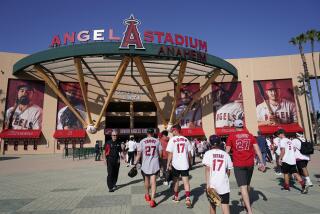News Analysis : 2 Elements Pivotal in Cutting Raider Deal
- Share via
In the tortuous process by which Raiders owner Al Davis eventually signed a contract to keep his football team in Los Angeles, two elements stand out.
First, the city had certain natural advantages in the bidding war with Oakland, Sacramento and Irwindale. The expected sales value alone of planned luxury boxes in the Los Angeles Coliseum could reach $12 million a year, and millions more could be realized in a renovated stadium by selling elite club seating. The prices that could be charged would be considerably higher than in smaller cities with fewer corporate headquarters or wealthy individuals.
Even without accounting for the eventual pay television potential, the long-term opportunities for profit in Los Angeles are greater by far. The city, a world entertainment center, is also a much more prestigious place for any team to play.
Was there ever a real chance, for instance, that Davis would give up all that to take a flyer on Sacramento? No less a Sacramento civic booster than Gregg Lukenbill, chief arranger of the Sacramento bid, in the end came to feel that the answer was no.
But the second element that stands out is that with all these advantages, Los Angeles had to overcome considerable handicaps as well.
The 67-year-old Coliseum was the only playing site the city could offer, and in its existing form it had neither luxury boxes nor club seats, making it positively antiquated by modern National Football League standards. Moreover, it was administered by a faction-ridden commission representing three levels of government.
Three years ago, when the bidding war for the Raiders began, the Coliseum Commission was led by developer Alexander Haagen, who was not even on speaking terms with Davis.
Furthermore, the commission had few financial assets of its own, and its ability to secure assistance from the city, the county and the state simultaneously, as would have been required, was next to nil. Even had the commission been unified, which it wasn’t, it would have been at a disadvantage. As it was, most of its members did not even like football.
In retrospect, things did not begin to come together for Los Angeles until local politicians, including Mayor Tom Bradley, City Council President John Ferraro and City Councilman Zev Yaroslavsky, had the idea to privatize the facility.
This, they reasoned, would put the responsibility for coming up with renovation plans and the money to finance them, as well as the large cash payments Davis was demanding, on a private business team that had the wherewithal to bring together what the commission could not.
Oakland, Sacramento and Irwindale all came to rely substantially on public money in making their bids. Los Angeles, using private business as it did during the 1984 Olympic effort, would avoid that necessity, and much of the political controversy that went with it. Even the faces of the negotiators would change.
In actuality, it proved more difficult than expected to secure a capable private bidder. Months passed before the Coliseum Commission was willing to grant the businessmen independent authority to make a bid. After this was done, one of the original partners, MCA Inc., quit the partnership. The other, Spectacor Management Group, had to overcome internal divisions before it was able to make a serious offer.
As these problems arose, Bradley become more involved. Dissatisfied with the efforts of his appointees on the Coliseum Commission, the mayor brought back a former commissioner, labor leader William R. Robertson, and made him and Deputy Mayor Mark Fabiani his point men.
Their job, assisted at key moments by the mayor himself, was to push the parties together as best they could, cajole the Spectacor executives into making ever more substantial offers, and encourage Davis to reach a decision.
By then, as the summer wound toward a close, the timing was right. Irwindale and Sacramento had long since fallen by the wayside. The second Oakland bid was much less substantial than the first, and Oakland authorities were having trouble settling on the terms of that smaller offer. The private Los Angeles bid ended up higher than Oakland’s.
And Davis, facing a new season with the Los Angeles fans turned off by the long uncertainty, wanted to decide.
The agreement that has been reached faces obstacles. There are complicated environmental and preservation requirements to be met before work on the revamped Coliseum can begin. Financing must be obtained. Further interventions by the mayor and his point men may be necessary to be sure Spectacor can perform, and it is possible additional partners may yet have to be brought in.
But for the time being, Los Angeles has secured the Raiders.
More to Read
Go beyond the scoreboard
Get the latest on L.A.'s teams in the daily Sports Report newsletter.
You may occasionally receive promotional content from the Los Angeles Times.










